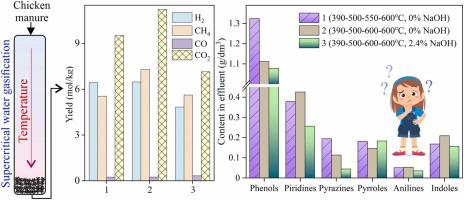The Journal of Supercritical Fluids ( IF 3.9 ) Pub Date : 2023-05-30 , DOI: 10.1016/j.supflu.2023.105998 Oxana N. Fedyaeva , Sergey V. Morozov , Anatoly A. Vostrikov

|
The article presents the research results of the chicken manure gasification in supercritical water. The experiments were carried out using a tubular flow reactor at a pressure of 25 MPa, a temperature gradient along its vertical axis (390–600 °C from top to bottom), and a chicken manure flow rate of 6.9–9.6 g/min, including experiments with the addition of NaOH (2.4 wt%). Data were obtained on the yield and composition of carbonized residues, volatile and liquid products, as well as the content of toxic substances (phenols, N-containing aromatics, and polyaromatic hydrocarbons (PAHs)) and mineral components in effluent collected at the reactor outlet. It is shown that an increase in the residence time of reagents in the high-temperature region of the reactor (HTR) improves the gasification efficiency. Using gas chromatography – mass spectrometry, it was revealed that phenol, pyridine, pyrazine, pyrrole, aniline, indole, quinoline, and their alkyl derivatives predominate in the composition of water-soluble products. The total content of phenols in effluent decreases from 1.3 to 1.1 g/dm3 when increasing the residence time of reagents in HTR, and does not depend on adding NaOH while the total content of N-containing aromatics decreases from 1.0 to 0.7 g/dm3 when adding NaOH. The content of PAHs, which is dominated by naphthalene, increases from 0.5 to 2.1 mg/dm3 in effluent when increasing the residence time of reagents in HTR. According to capillary electrophoresis data, increasing the residence time in HTR and adding NaOH result in increase of the content of NH4+ ions in effluent from 9.8 to 10.9 g/dm3.
中文翻译:

连续供入反应器的鸡粪超临界水气化
本文介绍了鸡粪在超临界水中气化的研究成果。实验使用管式流动反应器进行,压力为 25 MPa,沿其垂直轴的温度梯度(从上到下为 390–600 °C),鸡粪流速为 6.9–9.6 g/min,包括添加 NaOH (2.4 wt%) 的实验。获得了关于碳化残渣、挥发性和液体产物的产量和组成,以及反应器出口收集的流出物中有毒物质(酚类、含氮芳烃和多环芳烃 (PAHs))和矿物成分含量的数据. 结果表明,反应器高温区 (HTR) 中反应物停留时间的增加提高了气化效率。使用气相色谱-质谱法,据透露,苯酚、吡啶、吡嗪、吡咯、苯胺、吲哚、喹啉及其烷基衍生物在水溶性产品的组成中占主导地位。出水总酚含量从1.3 g/dm下降到1.1 g/dm3增加试剂在HTR中的停留时间,与添加NaOH无关,添加NaOH后含N芳烃总含量由1.0降低至0.7 g/dm 3。当增加试剂在 HTR 中的停留时间时,流出物中以萘为主的 PAHs 含量从 0.5 增加到 2.1 mg/dm 3 。根据毛细管电泳数据,增加在HTR中的停留时间和添加NaOH导致流出物中NH 4 +离子的含量从9.8增加到10.9 g/dm 3。


























 京公网安备 11010802027423号
京公网安备 11010802027423号